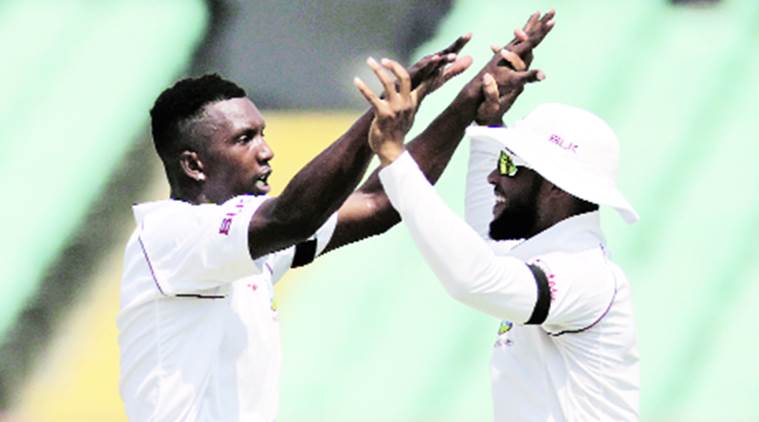
TWO PLAYERS, separated by four years and three first-class matches made their Test debut in Rajkot. The youngest, Prithvi Shaw turns 19 next month; Sherman Lewis 23 in a fortnight. The former had collected 17 first-class caps; Shaw 14. Lewis is tall and strapping, Shaw short and thick-set. Their first exposure into high-definition cricket ended contrastingly; Shaw became the youngest Indian batsman to score a century on debut. Lewis nearly bled a century — conceding 93 runs in 20 overs. Their narratives could diverge or converge, they could in future throw up heated duels or drift away, but first sightings in Test cricket go about, it was perceptible that Shaw was light years ahead of them, not only in terms of numbers but also in their Test-match readiness. You could argue that Shaw is perhaps a one-off talent, or that he was playing in familiar home climes against a blunt bowling force on an benign surface. But even if factor in all those variables, Shaw burst into the Test scene fully organised, equipped to deal with demands of Test cricket, while Lewis, equally hyped in the Caribbean, seemed a clueless novice on an exposure trip. Lewis was fished out of Mount Horne in St. Andrew, Grenada during a talent-hunt programme when the scouts were dazzled by an untrained 15-year-old flinging a ragged ball at unnerving pace. He was fast-tracked into the high performance academy and was blowing the helmets and ribs of fellow trainees; last year he had the discarded West Indies opener Kirk Edwards hopping and ducking in a gruesomely hostile spell. Yet, in the biggest moment of his budding career, he froze. It could have been just nerves, anxiety or plain callowness. In his first spell in Rajkot, Lewis was woefully erratic — either too full or too short, either way outside the off-stump or down the leg-side. He was not expected to blow them over like Curtly Ambrose or Patrick Patterson, but a nominal degree of control and maturity was expected of him. He can, at least whittle out excuses like Rajkot was intolerably hot, or the surface was unresponsive; even greats like Glenn McGrath and Mitchell Johnson have struggled to get a measure of the surface and condition in their first trip to the subcontinent. You could pardon a tearaway bowling the odd gift-ball, as long as most of deliveries are pounded on the spot, but Lewis couldn’t land four on the same spot. He would break down in the middle of the run-up, slip in his landing and lacked a clear-cut plan. His scalps were the two most precious Indian batsmen-Cheteshwar Pujara and Virat Kohli, but by then they had combined 225 runs between them, and got them off routine than rare deliveries. Thus, he seemed woefully amateur.
Not just Lewis, a spate of his recently-introduced colleagues too betrayed a lack of Test-match pedigree. For instance, Shimron Hetmyer, touted the most devastating batsman from the Islands since Chris Gayle. He attempted a hideous slog to perish, one that would have out tail-end Jacks to shame.
Like Lewis and Hetmyer, the nucleus of this side are barely experienced cricketers. Hetmyer, Lewis, Keemo Paul and Sunil Ambris have a collective experience of 13 Tests and 106 first-class matches. Then it’s not as much as about the quantity as it’s about the quality. Some of India’s debutants in the last year weren’t vastly experienced when they made their Test debut. Like Shaw, or Pant (who had appeared only in 23 first-class matches before his debut in Southampton) or Kuldeep Yadav (who had 20). Hanuma Vihari, though, was an exception.
But the bottomline is all of them seemed ready to the embrace of Test cricket, which wasn’t quite the case with Windies cricketers. Agrees former skipper Carl Hooper: “I can understand why they are handing untested youngsters their Test debuts, because there’s a player vacuum. But our domestic tournament is not as competitive as the Indians, and hence the players take a lot more time to mature as Test cricketers.”
It will be surprising if Lewis had ever bowled to a better batsman than Kohli and Pujara in the league or Hetmyer faced a wilier bowler than Ashwin. Phew, they were facing a second-string pace firmament of India. Back in his day too, West Indies hardly shied away from thrusting precociously-talented youngsters to the forefront. All of Brian Lara, Shivnarine Chanderpaul, Marlon Samuels, Chris Gayle and Hooper himself made their debuts in late teens or early 20s, but they all transitioned smoothly. “But back in the day, the domestic competition was really strong and hence it was producing a lot of quality players who could adjust to the requirements of this level,” Hooper points out. Until recently, the domestic league was a fine mess. There was no centralised contract for players until 2014, they hardly played seven-eight matches a year, the administrators and players were feuding and consequently, the Shield went through the hands of different sponsors before it could no longer woo financiers.
Financial, logistical nightmare
The WICB, subsequently, had to fund the tournament on their own — it’s a financial and logistical nightmare to conduct matches across scattered islands separated by miles. For example, Jamaica is closer to the USA than any of its Caribbean brethren.The buzz thus busted. “We used to long for these matches, which were as popular as international matches. All teams had legends. Antigua had the Benjamins and Curtly, Jamaica had Rose and Courtney. I always got a similar buzz on the morning of a match against them as for a Test in Australia,” he says. Now the stands are deserted, an empty silence rings across it, where once was always a full-fledged party.









